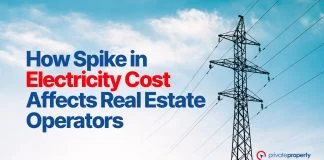24/7 Phone Services
Mon - Sat 8:00 - 5:30, Sunday - CLOSED

The recent surge in electricity costs is sending shockwaves through the real estate industry, with operators facing significant challenges to maintain profitability. As energy prices climb, both commercial and residential property owners are grappling with higher operating expenses, making it harder to manage buildings efficiently.
These rising costs not only impact day-to-day utility bills but also influence long-term investment strategies, tenant relations, and property values. In this post, we’ll explore how this spike in electricity costs is reshaping the real estate landscape and what operators can do to mitigate its effects.
The commercial real estate market is navigating a range of significant challenges, including high interest rates, an economic slowdown, and lingering effects from the post-pandemic era, all of which have created a fragile environment. These difficulties are further intensified by soaring electricity costs, the rising expense of power infrastructure, and increasing vacancies, along with declining property values, particularly in secondary office markets.
Real estate operators are raising concerns over the classification of energy consumption into feeder bands A, B, C, and others, which has caused a steep rise in commercial utility bills, tripling costs and severely impacting operational expenses.
The Nigerian Electricity Regulatory Commission (NERC) recently implemented a new classification system for electricity consumers, grouping them into Bands A, B, C, D, and E. As a result, those in Band A saw electricity tariffs skyrocket from N68/kWh to N225/kWh—a 240% increase—deemed unaffordable, particularly for businesses. Although later revised to N206.8/kWh and then to N209.50/kWh, the impact remains significant.
Under the new system, Band A customers are promised 20 to 24 hours of electricity daily, while Band B receives 16 to 20 hours, and Band C, 12 to 16 hours. Band D is allocated 8 to 12 hours of power daily, and Band E gets just 4 to 8 hours. Importantly, the recent tariff hikes primarily affect Band A customers, while those in Bands B, C, D, and E remain unaffected. In many retail spaces, electricity consumption per unit ranges between 393 and 457kWh/m2.
With the Band A classification, N50,000 now purchases only 225 units of electricity, down from 755 units, while N25,000 for Band B can buy just 372.2 units, compared to over 400 previously.
Adding to the strain, the escalating price of diesel—now over N1,100 per litre—has made running generators more expensive, with some commercial facilities spending as much as N2.5 million monthly on diesel to supplement grid supply. This situation is pushing tenants in commercial outlets to accept inconsistent power as a reality, while other service charges—such as security, cleaning, maintenance, and repairs—have risen by over 60%.
In response to these higher energy costs, many malls have increased their electricity charges by more than 300%, with facilities that previously spent N1.5 million on electricity now spending up to N4 million monthly.
In conclusion, the spike in electricity costs, coupled with rising diesel prices and service charges, is creating a challenging environment for real estate operators in Nigeria. The reclassification of electricity into feeder bands has dramatically increased operational expenses, particularly for businesses in Band A, where utility bills have skyrocketed. With the cost of energy becoming unsustainable for many, commercial outlets are forced to raise their fees, further burdening tenants already struggling with inconsistent power supply and increased service costs. To remain viable, operators will need to explore alternative energy solutions and more efficient management strategies to navigate these financial pressures.

Leave A Comment